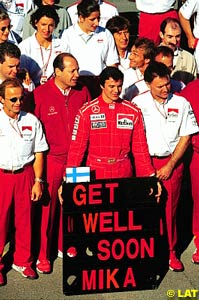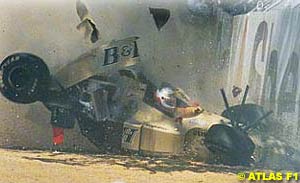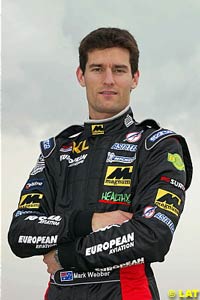
Atlas F1 Magazine Writer
How many times did Australia host the title deciding race? When was the last time a team started the season with last year's car? And how did the current drivers do in previous years on this track? Marcel Schot brings the answers and more anecdotes on the Australian Grand Prix
On the other hand, Australia's not only a place of joy and excitement. Only last year, marshall Graham Beveridge lost his life after being hit by a wheel that flew off Jacques Villeneuve's crashed car. Six years before, Mika Hakkinen narrowly escaped death after a serious crash in practice.
During Friday's practice session for the 1995 Grand Prix at Adelaide, the Finn approached the bend leading onto the Brabham straight at full speed when a piece of debris pierced his left rear tyre. As a result, the car was catapulted over the inside kerb and was airborne. Without any contact with the asphalt, there was nothing but the barrier across the street to stop the McLaren. Only the prompt reaction and good decisions of the trackside marshalls saved Mika Hakkinen's life.
Only months later, Formula One returned to Australia and another horrific looking crash took place. On the first race lap on the new Albert Park circuit, Martin Brundle's Jordan was launched over the back of David Coulthard's McLaren and Johnny Herbert's Sauber. Luckily, this looked worse than it was. The car appeared to completely disintegrate, but the monocoque was intact and Brundle climbed out unhurt, and even running back to the pitlane, looking for Professor Sid Watkins in order to get the chief medical officer's permission to take part in the restart of the race! The Briton did indeed get his permission, started from the pits... and spun out after a single lap.
Incidently, that race was only the fifth in Formula One history that took place in the same country as the previous race. In three previous cases, this was due to one country having two races in the same season, namely the Pescara and Italian Grands Prix in 1957, the American Grands Prix in Detroit and Dallas in 1984, and the Pacific and Japanese Grands Prix in 1995. The only other time one season finished in the same country as the next season started, was in 1980/81, when the season ended with the US Grand Prix at Watkins Glen and the next season began with the US-West Grand Prix at Long Beach.
The points per finishing place in the CC are as follows:
That's 72 points for the champion against 84 for all the others combined!
In short, the team that dominates the Australian Grand Prix is the one to put your money on. Of course, the saying "past results give no guarantee for future success" fully applies here, so don't sue me if you lose money by following this tip.
That the 7th, 8th, and 9th position finishers in the Championship score as well, shows that the smaller teams have a chance to grab a point in the opening round of the season, most commonly because the faster teams don't have their reliability sorted out right from the start of the season.
In fact, reliability issues in the opening race have been getting increasingly worse over the years:
So far, this decade shows an alarming increase in retirements in the first race of the season. In light of that, Ferrari's choice to start with the 2001 car might prove to be a smart decision. The last time a team started with the same car as they ended the previous season was in 1990. Back then AGS, Arrows, Brabham, Minardi, Onyx, Osella and Tyrrell started the season with their 1989 models. As a matter of fact, the oldest car used in a World Championship Grand Prix was also a Ferrari. Back in 1966, Reg Parnell Racing entered a Ferrari 246 from 1958 in several Grands Prix.
However, this wasn't the first time a driver ran out of fuel on the streets of Australia. In the 1986 Grand Prix, Philip Streiff ran out of fuel in his Tyrrell, while in the 1988 race Andrea de Cesaris (Rial), Stefan Johansson (Ligier) and Philip Alliot (Lola) all suffered the same fate. The only difference is that those four had their event at the end of the race in a time when refueling was not allowed.
This year Toyota will make their debut in Australia, as will Takuma Sato, Allan McNish, Felipe Massa, and Mark Webber. For Mark Webber it will be a very special debut, seeing as it comes at his home country. The Minardi driver will be only the third Australian to compete in a home Grand Prix - Alan Jones was the first, when he drove in Adelaide with Lola in 1985 and 1986, while David Brabham did the same in 1990 with Brabham and 1994 with Simtek. All four attempts ended in retirement. This of course means that Webber can write history by finishing the race. Furthermore, in case he manages to score a point, he'll be the first to score in his debut on home soil since Jean Alesi finished fourth in the 1989 French Grand Prix.
Even though the Australian Grand Prix hasn't been part of the World Championship for a long time, it always had a special position on the calendar. Over the last six seasons it hosted the opening Grand Prix of the season, while from 1985 until 1995 it was the closing race. However, only in 1986, 1988 and 1994 was the Australian Grand Prix a title deciding race. That is three out of 11 times that the title showdown came into the final race of the season:
United States 5/12 (42%) (including 1 US-East & 2 US-Las Vegas)
Australia 3/11 (27%)
Japan 5/ 7 (71%)
Mexico 3/ 7 (43%)
Italy 2/ 6 (33%)
South Africa 2/ 3 (67%)
Spain 2/ 3 (67%) (including 1 European GP)
Canada 0/ 1 (0%)
Morocco 1/ 1 (100%)
Portugal 1/ 1 (100%)
---------------------------
Total: 24/52 (46%)
 What is more interesting about Australia having the final race of the season, is that many drivers end the weekend in a vacation mood. As the end of the year approaches, spring is in the air in the southern hemisphere and the atmosphere is more laid back than usual. At the final season ending, the Australian Grand Prix at Adelaide in 1995, a band consisting of Damon Hill, Eddie Jordan, Johnny Herbert and David Coulthard performed on stage with a nice rendition of Roy Orbison's "Oh Pretty Woman".
What is more interesting about Australia having the final race of the season, is that many drivers end the weekend in a vacation mood. As the end of the year approaches, spring is in the air in the southern hemisphere and the atmosphere is more laid back than usual. At the final season ending, the Australian Grand Prix at Adelaide in 1995, a band consisting of Damon Hill, Eddie Jordan, Johnny Herbert and David Coulthard performed on stage with a nice rendition of Roy Orbison's "Oh Pretty Woman".
 So, after years of season finale, the Australian Grand Prix became the season opener in 1996. Since that year, the opening round of the season was by far the most successful for Ferrari, who scored 53 points. McLaren (38) and Williams (30) follow the Maranello team, while Benetton (11), Jordan (8) and Sauber (6) lead the rest. In fact, only in 1997 did the eventual Constructors' Champion not score the most points in the opening round of the season.
So, after years of season finale, the Australian Grand Prix became the season opener in 1996. Since that year, the opening round of the season was by far the most successful for Ferrari, who scored 53 points. McLaren (38) and Williams (30) follow the Maranello team, while Benetton (11), Jordan (8) and Sauber (6) lead the rest. In fact, only in 1997 did the eventual Constructors' Champion not score the most points in the opening round of the season.
1st 72 points
2nd 19 points
3rd 22 points
4th 24 points
5th 10 points
6th 6 points
7th 1 point
8th 1 point
9th 1 point
50s: 76 / 221 (34%)
60s: 79 / 209 (38%)
70s: 94 / 236 (40%)
80s: 126 / 285 (44%)
90s: 133 / 269 (49%)
00s: 26 / 44 (59%)
 Retirements are not always due to the car breaking down - something Jean Alesi proved during the 1997 Australian Grand Prix. The recently retired Frenchman ignored all signals from the pits to come in for a stop for various laps and eventually the Benetton driver ran out of fuel. "He didn't even see our 'two-meter-man' Nick Wirth with the sign," team principal Flavio Briatore exclaimed afterwards. "Alesi is an idiot and even a blind one."
Retirements are not always due to the car breaking down - something Jean Alesi proved during the 1997 Australian Grand Prix. The recently retired Frenchman ignored all signals from the pits to come in for a stop for various laps and eventually the Benetton driver ran out of fuel. "He didn't even see our 'two-meter-man' Nick Wirth with the sign," team principal Flavio Briatore exclaimed afterwards. "Alesi is an idiot and even a blind one."
Past Performance by Current Drivers
| 1996 | 1997 | 1998 | 1999 | 2000 | 2001 | Average Qualifying Position |
|||||||
| Qual | Race | Qual | Race | Qual | Race | Qual | Race | Qual | Race | Qual | Race | ||
| M.Schumacher | 4 | M | 3 | 2 | 3 | M | 3 | 8 | 3 | 1 | 1 | 1 | 2.833 |
| Barrichello | 8 | M | 11 | M | 14 | M | 4 | 5 | 4 | 2 | 2 | 3 | 7.167 |
| Coulthard | 13 | M | 4 | 1 | 2 | 2 | 2 | M | 2 | M | 6 | 2 | 4.833 |
| Raikkonen | - | - | - | - | - | - | - | - | - | - | 13 | 6 | 13.000 |
| R.Schumacher | - | - | 12 | M | 9 | R | 8 | 3 | 11 | 3 | 5 | R | 9.000 |
| Montoya | - | - | - | - | - | - | - | - | - | 11 | M | 11.000 | |
| Heidfeld | - | - | - | - | - | - | - | - | 15 | 9 | 10 | 4 | 12.500 |
| Massa | - | - | - | - | - | - | - | - | - | - | - | - | - |
| Fisichella | 16 | M | 14 | R | 7 | R | 7 | 4 | 9 | 5 | 17 | 13 | 11.667 |
| Sato | - | - | - | - | - | - | - | - | - | - | - | - | - |
| Villeneuve | 1 | 2 | 1 | R | 4 | 5 | 11 | M | 8 | 4 | 8 | R | 5.500 |
| Panis | 11 | 7 | 9 | 5 | 21 | 9 | 20 | M | - | - | 9 | 7 | 14.000 |
| Trulli | - | - | 17 | 9 | 15 | M | 12 | R | 6 | M | 7 | M | 11.400 |
| Button | - | - | - | - | - | - | - | - | 21 | M | 16 | 14 | 18.500 |
| Frentzen | 9 | 8 | 2 | 8 | 6 | 3 | 5 | 2 | 5 | M | 4 | 5 | 5.167 |
| Bernoldi | - | - | - | - | - | - | - | - | - | - | 18 | R | 18.000 |
| Irvine | 3 | 3 | 5 | R | 8 | 4 | 6 | 1 | 7 | R | 12 | 11 | 6.833 |
| de la Rosa | - | - | - | - | - | - | 18 | 6 | 12 | M | - | - | 15.000 |
| Yoong | - | - | - | - | - | - | - | - | - | - | - | - | - |
| Webber | - | - | - | - | - | - | - | - | - | - | - | - | - |
| Salo | 10 | 6 | 18 | M | 16 | M | - | - | 10 | DQ | - | - | 13.500 |
| McNish | - | - | - | - | - | - | - | - | - | - | - | - | - |
Please Contact Us for permission to republish this or any other material from Atlas F1.
|
Volume 8, Issue 9
Australian GP Preview
The Australian GP Preview
Local History: Australia's Grand Prize
Australian GP: Facts, Stats & Memoirs
Tech Focus: Bi-Directional Telemetry
Columns
The Australian GP Quiz
Rear View Mirror
Bookworm Critique
The Grapevine
> Homepage |